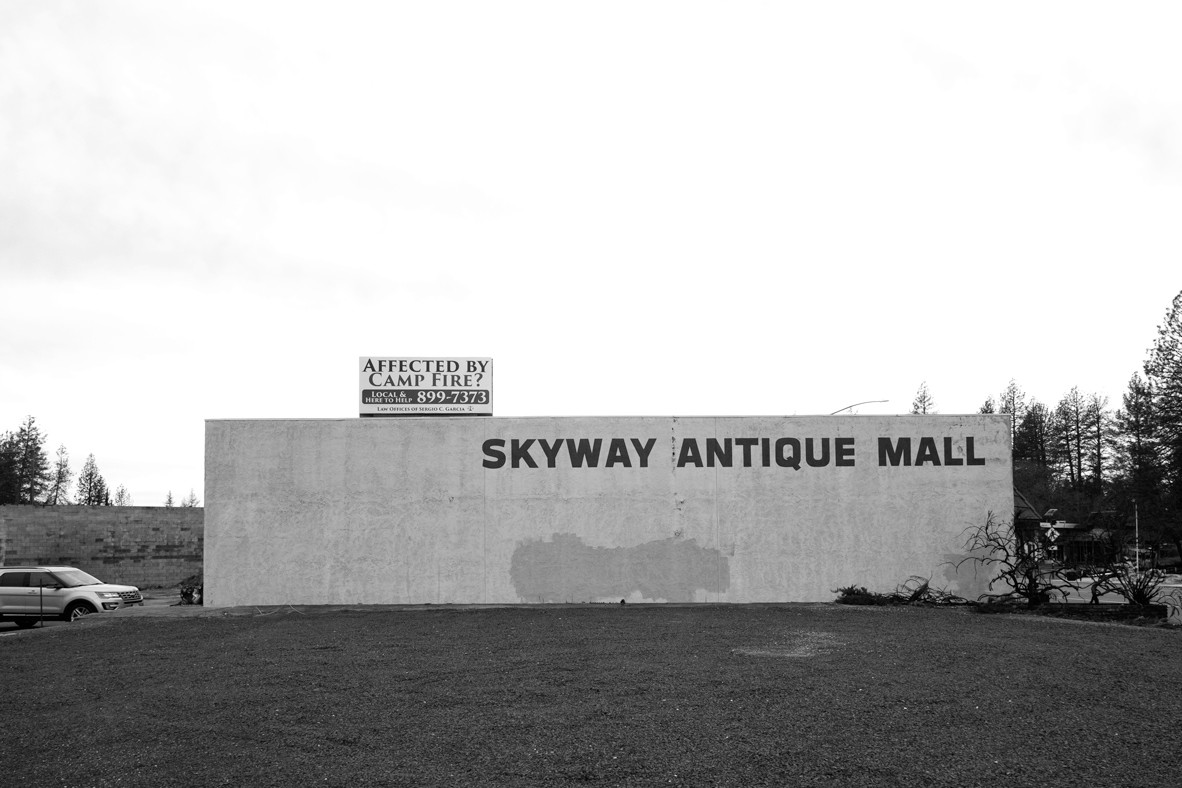Prior to the Camp Fire, the beautifully wooded Sierra foothill community of Paradise was home to 26,218 residents with a median age of 50. The area was initially settled by the First Nations Maidu tribes. In time, Paradise became a lumber camp and later, a progressive farming district.
The future of Paradise is now precarious at best. Local businesses, facing a boil water order, are struggling to reopen; the lack of water is a crippling blow, especially to food service businesses.
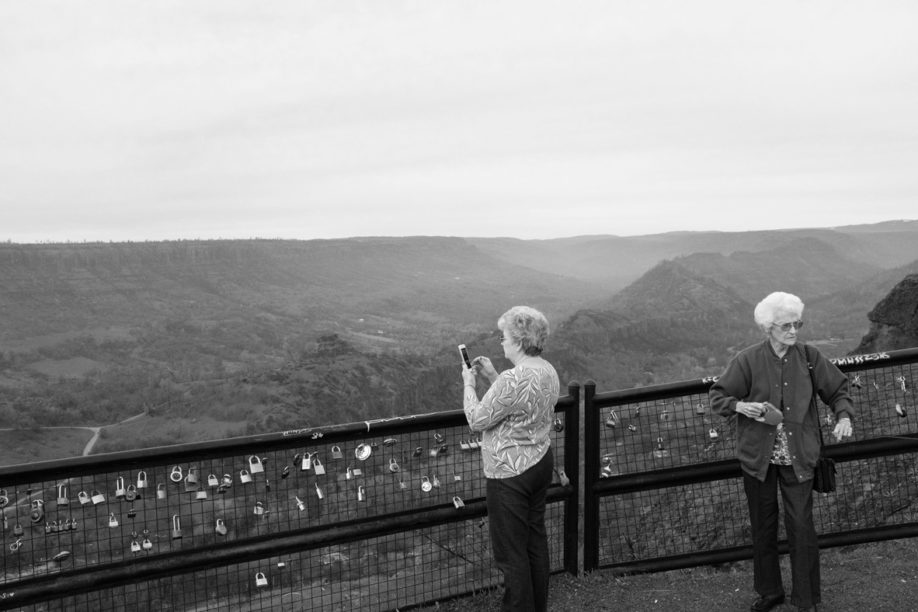
Viewing the Camp Fire’s burn area in the Butte Creek Watershed
The Camp Fire began on the morning of November 8th, 2018 and burned 153,336 acres, qualifying it as a “megafire” having destroyed more than 100,000 acres. 13,972 residences, 528 commercial buildings, and 4,293 other buildings were destroyed. Eighty-five residents were killed in the fire; three remain missing.
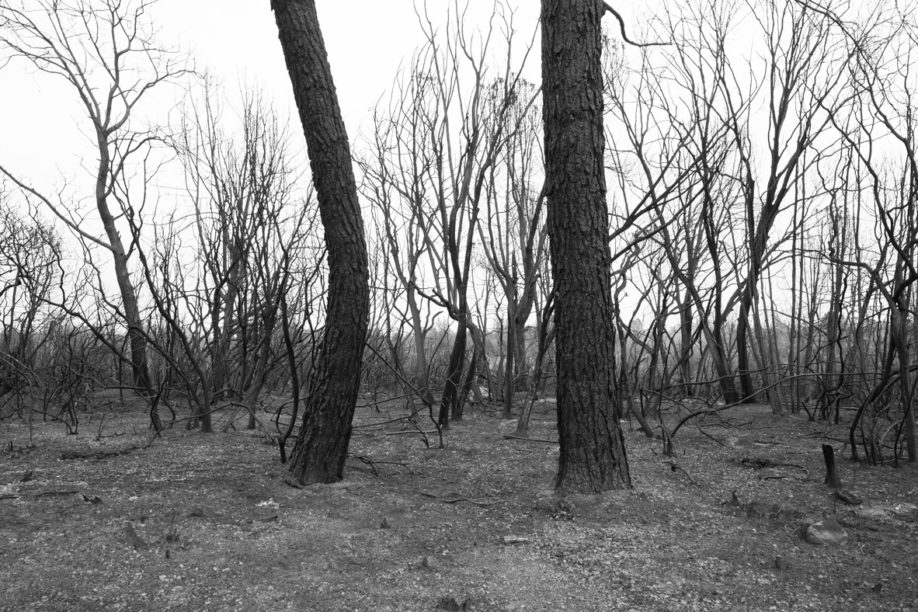
Federal employees not authorized to speak to the media told the San Francisco Chronicle that fire suppression programs in national parks and forests won’t be fully staffed when the next fire season begins, due to planning and hiring delays caused by the recent government shutdown.
Wildfires have been “successfully” fought in the greater Western United States for more than 100 years. Until 1978, the Forest Service maintained a policy that every reported wildfire would be out by 10:00am the following day, and failing that, by 10:00am the second day after reporting. Such policies effectively prevented healthy forest ecosystems from thinning their combustible mass. The density of undergrowth and combustible fuels on forest floors consequently increased to critical levels, while the number of trees per acre skyrocketed—in some places achieving 50 times the ordinary number of mature trees per acre. The consequences of this unnatural fuel loading are predictable.
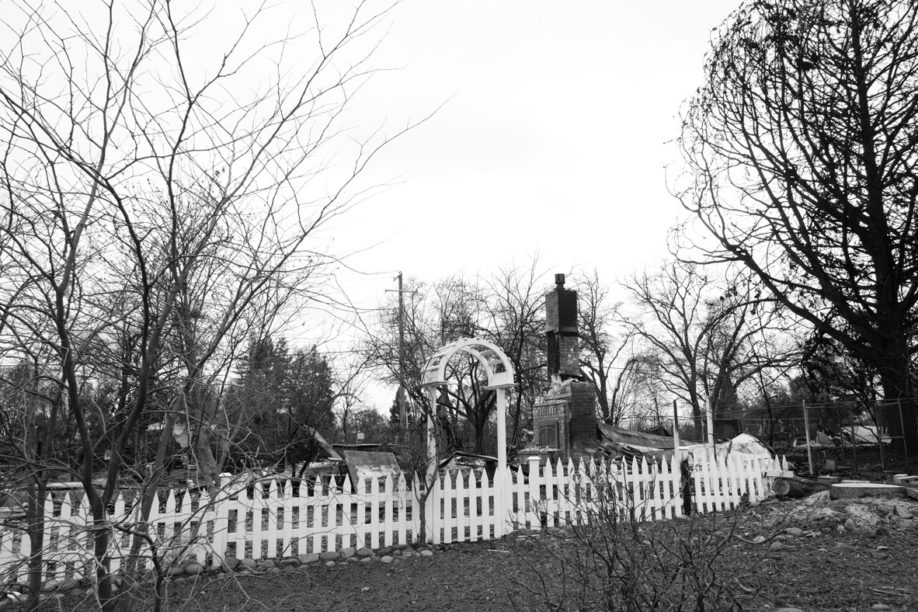
The Camp Fire immolated structures while leaving trees standing, creating snags of some of the remaining trees; snags are dead trees with compromised structural integrity in danger of falling.
The apparent contradiction of trees left standing on residential blocks otherwise entirely destroyed is not uncommon. Powerful fires spread embers, called firebrands, ahead of the main conflagration. These firebrands can travel extraordinary distances and, in high wind events, often possess a surprisingly large mass. Firebrands fly from structure to structure, igniting buildings, which burn hot enough to scorch tree bases and kill tree foliage, though the speedy passing of the fire below allows the trunks to remain standing.
The remaining snags are among the most dangerous elements of wildland firefighting, as they are at risk of unexpectedly collapsing and killing firefighters.
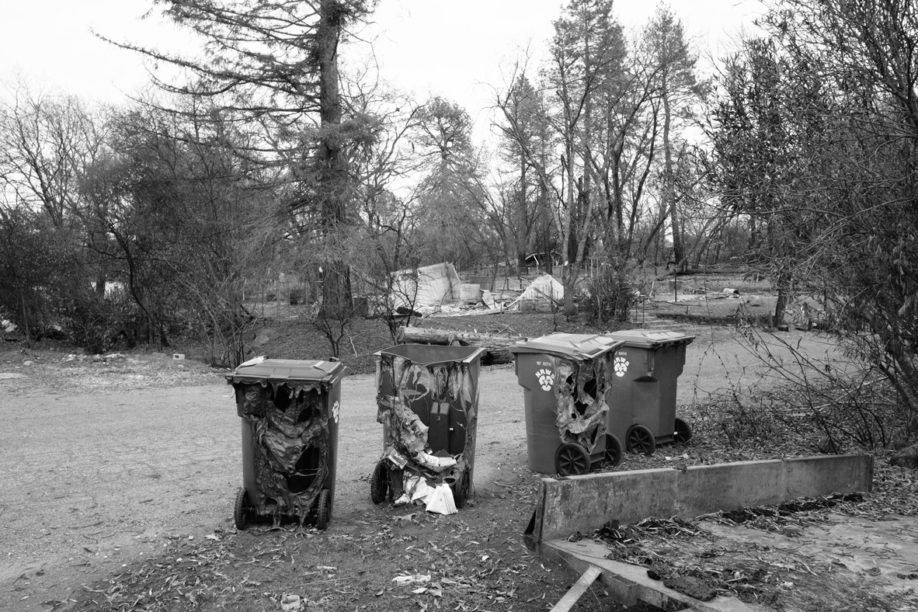
The California Fire Code demands 100’ of defensible space measured from any point on the plane of an exterior of a structure or overhang in wildfire prone areas. This requirement necessarily ends at every individual property line. In rural and suburban developments of homes on parcels of less than an acre, the Code’s defensible space obligation is individually unenforceable; it must be maintained community-wide.
Western residents are famously averse to being told what to do on their property, while firefighters find it galling to be called on to defend properties and developments that have resisted adhering to fire prevention hygiene, often in defiance of department orders.

Crown fires, wildfires which burn through and travel within the crowns of trees, are spectacular, devastating fires that leave felled and charred trees in their paths.
Fires like the Camp Fire are a mix of structure fires, forest fires, and brush wildfires, each type demanding its own specific suppression techniques. Urban firefighters are trained to attack fires in buildings, while wildfire fire crews are trained to stop fires in wildlands, using techniques entirely different from those employed in fighting structure fires. Few firefighters are certified as incident commanders in the simultaneous management of multiple types of fires.
In the case of terrifyingly fast-moving Type I fire incidents like the Camp and Tubbs fires, there is often little that officials can do to stop or slow the fire’s advance, and evacuation is the critical priority. The time pressure necessarily means allowing structures to burn completely, resulting in a level of destruction rarely seen outside of wartime.

Steel, for the most part, maintains 100% of its design capacities for strength and resilience to deformation up to temperatures of about 600ºF. Steel loses half of its design strength at 1000º and loses 100% of its design capacities at 2,200º, about 500º below its outright melting point.
Incinerating structure fires like that which destroyed Paradise burn at temperatures hot enough to entirely consume wood framing, interior furnishings, and nearly everything a building might contain, leaving behind few artifacts of the lives lived in these destroyed buildings.
Among the very few household artifacts that can survive fires that burn as hot as the Camp Fire are the cremains that families often preserve at home. A specialized team of archeologists from ALTA Archeological Consulting, using dogs trained to discover human remains, worked to recover the cremains of loved ones in the destroyed homes of survivors of the Camp Fire.
Without the archeologists’ help, the undiscovered cremains would end up in landfills. As of mid-January the team had recovered 53 sets of cremains. The team works for free with the goal of using their specialized skills to reunite families upended by fire.

Massive wildfires leave behind hazardous material conditions, especially when they burn through areas of human habitation. Heavy metals, chemical, and groundwater contamination can be left behind. Every one of the 18,793 buildings destroyed in the Camp Fire has to be inspected by a hazmat crew and judged either safe or in need of immediate hazardous materials recovery, even before more general remediation of the building site. This initial inspection process does not regard the ash itself, which is considered a chemically hazardous material.
The environmental consequences of today’s massive fires don’t end when the fire is out and the smoke clears. They have the potential to last well beyond the incident and require significant remediation, especially to prevent ground and surface water contamination by ash flows. The cost of these necessary, difficult cleanups is enormous; Santa Rosa’s Tubbs Fire cleanup cost $1.3 billion. The Tubbs Fire burned a quarter of the structures lost to the Camp Fire.

Village Square was a forty-unit condominium complex reduced entirely to ash. The Camp Fire effectively destroyed the towns of Paradise and Magalia as well as the unincorporated community of Concow; the communities of Centerville, Butte Creek Canyon, and Yankee Hill were also damaged.
California is already facing a substantial housing shortage, and the loss of so many relatively affordable dwellings in the burn area hits hard. Before the fire, Butte County’s rental vacancy rate was about 3%; today it is near zero. The burned area was home to a substantial number of elderly and impoverished people, many of whom are facing homelessness after surviving the fire. The fire destroyed 14% of the county’s housing stock.

Forty-seven buildings with frontage on Skyway Road were burned to the ground, including the local Chamber of Commerce. It’s estimated that the cleanup process before rebuilding will take a year or more.
A base camp has been set up with dormitories, mess halls, shower, and laundry facilities to serve workers, and prevent their influx from further pressuring housing resources. They will remove hazardous materials, toxic ash, recyclables, burned vehicles, building foundations, and the contaminated soils beneath. Property owners must sign up and allow access to enable the government cleanup process; otherwise, owners are obligated to hire and manage their own cleanup to the same environmental standard, or face having their properties declared a nuisance. Near the extended February deadline, nearly one-third of eligible owners had resisted filing the right-of-entry forms to facilitate cleanup, which grant the government access to their property for three years.

The Environtmental Protection Agency (EPA) is leading the cleanup effort, with the help of state agencies focusing on the initial removal of readily identifiable hazardous materials such as building asbestos, batteries, chemicals, and stored fuels. The Federal Emergency Management Agency (FEMA) is working with CalRecycle to subsequently remove nonhazardous debris such as the roof system pictured here.
The EPA phase of the cleanup alone is expected to cost tens of millions of dollars. Neither the EPA cleanup nor FEMA’s secondary phase will cost homeowners. Expectations are that the Camp Fire cleanup will cost at least $3.5 billion and will be the largest fire cleanup in California history. Once debris removal is complete, soils sampling will be undertaken at every burned property to ascertain what further remediation might be required. Only then will sites be ready for rebuilding.

Mama Celeste’s Pizzeria, 5522 Skyway Road, is one of many restaurants destroyed in the fire. The enormous number of structures burned presents a unique problem with regard to meeting the goal of recycling at least a fifth of the debris.
The cleanup effort will require thousands of round trips of over one hundred miles each by truck, to transfer facilities that will in turn send metals and concrete by rail to sites in Nevada and Utah for recycling. Contaminated ash and soils will be wrapped and trucked to area landfills, also requiring round trips of more than one hundred miles. This heavy traffic will prematurely wear roads, requiring repaving outside of CalTrans and local repaving schedules.
As massively destructive wildfires increasingly burn into developed areas like Santa Rosa and Redding, concern is mounting that the burden on local landfill space will quickly overtax waste stream management plans. It is estimated that the nearest landfill to the Camp Fire burn area, Anderson, has about sixty years’ capacity remaining. A Waste Management executive estimates that Camp Fire debris alone will use five years’ worth of that capacity.

Cleanups such as these demand a dizzying amount of management. Hazmat crews must be assembled, equipped, and deployed; specialized machinery to cut and pile up miles of downed power lines must be obtained, and dangerous snags and dead and fallen trees cut and removed. Bids must be solicited for toppling chimneys, excavating building foundations, and carting off their remains. Thousands of such process steps must be taken and accounted for in the remains of the firestorm.
In California, six of the ten most destructive wildfires in the state’s history have occurred in the last three years. Work in the fire zones comes at the expense of mandated work in other areas of disaster preparedness. This increases the chance of significant consequences from flooding, earthquakes, infectious disease outbreaks, and other disasters.

“None of us are OK, let’s get that shit straight. There is no template for losing three communities in three hours,” said therapist Matt Reddam, a mental health and counseling contractor who works as a consultant to the Butte County Office of Education. With so many dead, displaced, and otherwise affected, there is simply no precedent for this scale of mental health recovery effort in California’s history.
Eighty-five people were killed in the Camp Fire, principally in Paradise and Magalia. The missing persons list reached a peak of more than 1,000 people, eventually lowered to three. Forensic anthropologists were called in from out of state to aid the search, sifting sites for remains. Archeologists used dogs trained to identify human bone fragments. But even with these extraordinary efforts, there are people among the dead whose bodies will never be identified or even recovered.

